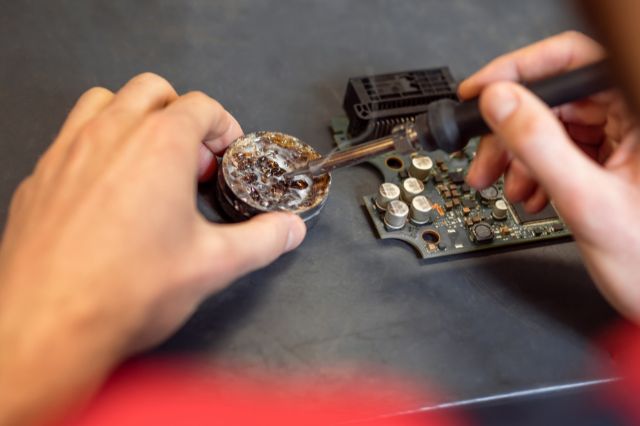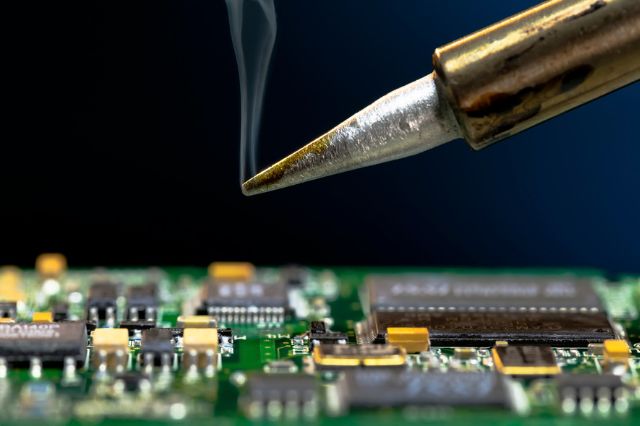Soldering is an essential skill for many electronics projects, but it’s easy to make mistakes if you’re not careful. This guide explores the seven most common soldering mistakes and offers practical advice on how to fix them. By understanding where things often go wrong, you can take steps to improve your soldering technique and ensure more reliable connections.
The Most 7 Common Soldering Mistakes
1- Disturbed Joints
Disturbed joints arise when there is movement of any kind during the cooling/solidifying of the solder. This movement can be an unstable work surface or human error which will cause the solder to become distressed before it has completely solidified. The result is a weak bond that might not conduct electricity reliably or hold up to physical stress.
Disturbed solder joints are often misinterpreted as a cold joint and are indeed similar but have different causes.
To fix this issue, you can reheat (reflow) the joint and let it cool correctly. To avoid this problem in the future, identify any potential sources of vibration and make sure to stabilise everything properly during the soldering process. As there is likely to be very little or no flux left, additional flux is sometimes required.
2- Cold Joints
Cold joints occur when the solder does not melt completely, often due to the soldering iron not being hot enough, having insufficient power output or not applied long enough. These joints appear dull, rough, and may have a lumpy or round shape that indicates poor integration with the surface, pin, or pad.
The remedy for cold joints is to use a soldering iron set at the correct temperature and fitted with a soldering tip suitable for the application. Ensure your iron reaches between 350°C to 375°C, which is optimal for most solder types. Always heat the joint adequately before applying solder and maintain the iron’s contact until the solder flows smoothly and covers the necessary areas.
3- Overheated Joints
Overheating is another frequent mistake, where the soldering iron is left on the joint too long or is set at too high a temperature. This can damage components, the adhesive holding the pads onto a PCB, or burn off the flux too quickly or even burn the flux itself, preventing it from cleaning the metal surfaces properly. Overheated joints often have a burnt appearance and may form weak connections.
An overheated joint can become weaker due to the increase in the intermetallic interfacial area where the solder bonds to the metals being soldered and is the most brittle part of a soldered joint.
To avoid overheating, closely monitor the amount of time your iron makes contact with the joint. Adjust the temperature setting based on the solder’s specifications and the materials involved.
It is better to start with a lower temperature and increase as necessary than to start with too hot a temperature.
Typically, maintaining a slightly lower temperature and increasing contact time can result in a better-controlled soldering process without risking heat damage.
4- Insufficient Wetting
Insufficient wetting occurs when the solder fails to adequately coat and bond with the metal surfaces involved in soldering. This can lead to weak joints that are unreliable and prone to failure. Let’s break down the solutions for this common soldering mistake across three specific areas: surface mount terminations, through hole terminations and pads.
Insufficient Wetting of Surface Mount Terminations
In the case of surface mount terminations, insufficient wetting can prevent the solder from properly adhering to the component, affecting the overall reliability and functionality of the electronic device. To ensure proper wetting, apply a sufficient amount of suitable flux to both the surface mount termination and the board before you begin soldering. The flux cleans the metal and helps the solder flow across it. Make sure the soldering iron is set to the correct temperature for the specific type of solder you are using. Carefully heat the area and allow the solder to flow naturally without forcing it into place
Insufficient Wetting of Through Hole Terminations
When soldering pins, such as those on through-hole components or connectors, it’s crucial that the solder forms a good connection around each pin. If a pin isn’t properly wetted, it might not make a secure electrical connection.
To address this, direct the tip of your soldering iron where the pin meets the pad, ensuring both are heated simultaneously. This dual-contact approach helps the solder melt and flow evenly. Use just enough solder to coat the pin and pad sufficiently and smoothly, without overflowing onto the PCB surface, which can prevent accidental connections to nearby components.
Insufficient Wetting of the Pad
Insufficient wetting of the pad often occurs due to a number of reasons including but not limited to oxidization or contamination, a lack of heat or insufficient flux. This can result in a joint that is weak and does not extend over the entire pad, potentially leading to a loss of electrical connectivity.
To fix this, begin by cleaning the pad thoroughly with a small brush and isopropyl alcohol before applying a new layer of flux. Then, reheat the pad with the soldering iron while simultaneously applying a small amount of fresh flux cored solder. Ensure the solder melts completely and spreads out to cover the entire pad. Keep the iron in place for a second or two after applying the solder to allow it to fully take shape and create a strong bond.

5- Excess Solder
Using too much solder can lead to blobs or bridges that connect points that should not be connected, potentially causing short circuits. Excess solder makes it difficult to evaluate the quality of the joint underneath and can hinder troubleshooting or rework.
Control the amount of solder you apply by using a fine-tip soldering iron and applying the solder wire incrementally. This allows you to gauge how much solder is needed to adequately cover the joint without spilling over onto adjacent circuits.
It is a common misconception that “the bigger the blob, the better the job”, but in reality, this can create a poor joint and hide problems, so the preference is to have solder that is ‘volcano’ shaped where the solder thins out at the ends which indicates good wetting.
6- Lifted Pads
Lifted pads is another common soldering mistake that occurs when the pad on the PCB separates from the board. This is usually because of excessive heat or mechanical stress from incorrect soldering or reworking techniques. This can render a circuit intermittent or non-functional as it breaks the connection between the component and the board’s trace. Additionally, the mechanical reliability is affected which can cause failure during movement and vibration situations.
To prevent pad lifting, use minimal pressure when applying the soldering iron and avoid pulling or pushing on the component while the solder is solidifying. Also, ensure your iron is not set too hot, as excessive heat can weaken the adhesive that binds the pad to the PCB substrate.
A common reason for lifted pads when using a desolder pump when reworking is often due to either a faulty or incorrect operation of the pump. A faulty pump will have ineffective suction, resulting in a severe recoil of the pump which can cause the tip to knock the iron onto the pads.
7- Solder Bridges
Solder bridges form when excess solder connects adjacent pads or pins that should not be connected. This mistake can cause short circuits and malfunctioning of electronic circuits.
The best way to avoid solder bridges is to use a fine-tip iron and precise amounts of solder, ensuring the iron only contacts the joints being soldered and not adjacent joints at the same time. If a bridge does form, use a solder wick or desoldering pump to remove the excess solder but ensure that additional solder is added after as these rectification processes often take too much solder off. Practice careful technique to apply only as much solder as needed for each joint.
Work With The Electronics Group To Enhance Your Soldering Skills
Improving your soldering skills involves understanding the most common soldering mistakes and knowing how to prevent them. As well as how to fix any issues effectively. At The Electronics Group we run a range of skills courses that dive deeper into soldering skills and trouble shooting. You can see our full range of skills courses here.
We also hold certified IPC training courses to allow you to put your soldering skills to the test and learn to work to IPC standards. Get in touch with our team today to find out more about which training courses are right for you.
Keep refining your skills and your projects will not only perform well, but they’ll also stand the test of time.


